Reward Management: Strategy, Ethics and Impact in Retail
VerifiedAdded on 2023/06/16
|19
|6672
|56
Report
AI Summary
This report provides a comprehensive analysis of reward management within a retail organization, addressing both internal and external factors influencing reward systems, particularly the introduction of performance-related pay. It evaluates the potential impact of economic and environmental factors, as well as budgetary constraints and CEO approval processes. The report applies motivation theories, such as Maslow's hierarchy of needs and Adam's equity theory, to assess the success of reward approaches, highlighting their strengths and weaknesses. It further explores intrinsic and extrinsic reward strategies to motivate employees, designs a tailored reward strategy for the retail setting, and considers the ethical implications and professional approach required for performance-related pay schemes, including their impact on expatriates. The report concludes by evaluating key issues in reward management and proposes mitigation strategies, providing a holistic view of reward systems in the retail sector. Desklib offers a wealth of similar resources for students.
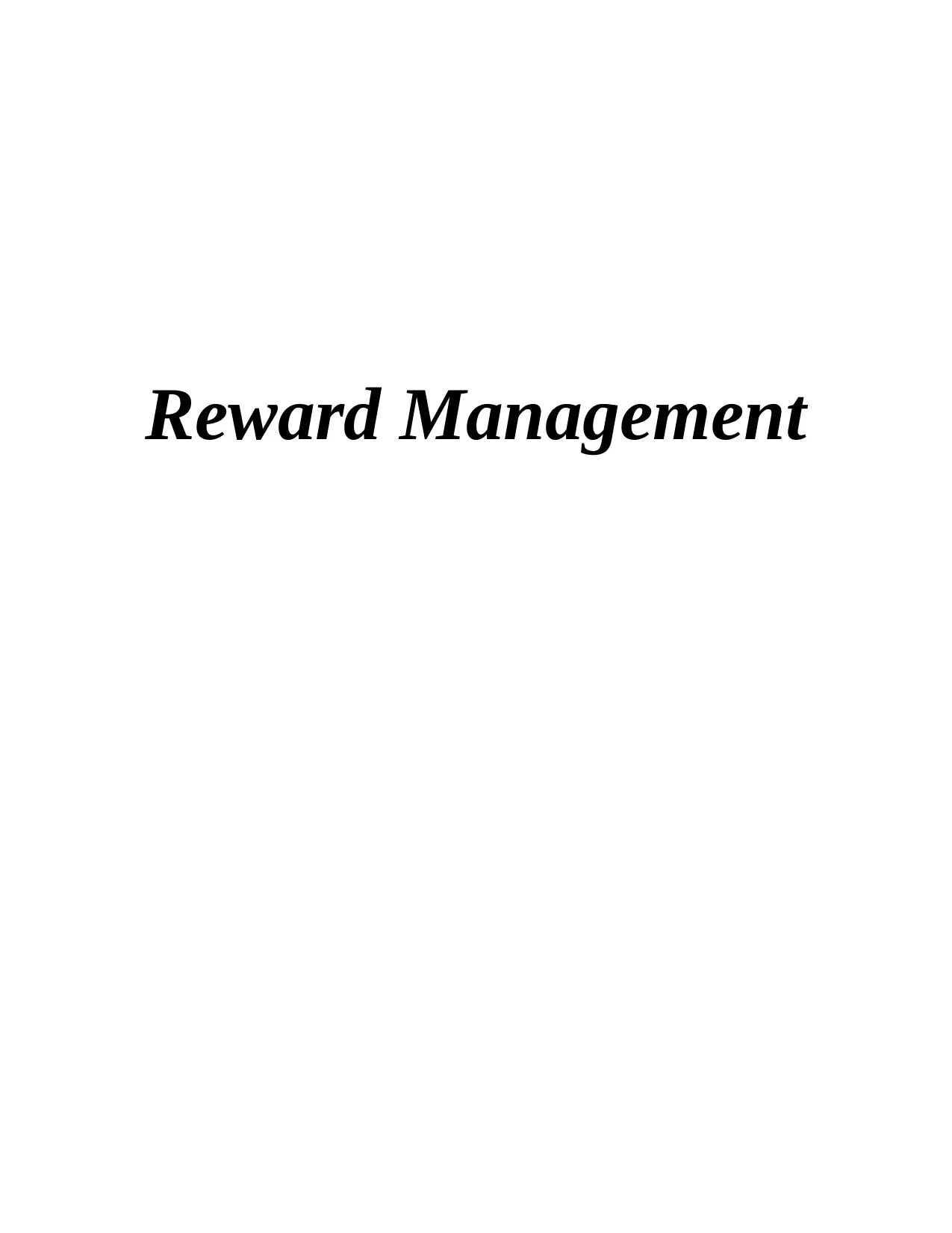
Reward Management
Paraphrase This Document
Need a fresh take? Get an instant paraphrase of this document with our AI Paraphraser
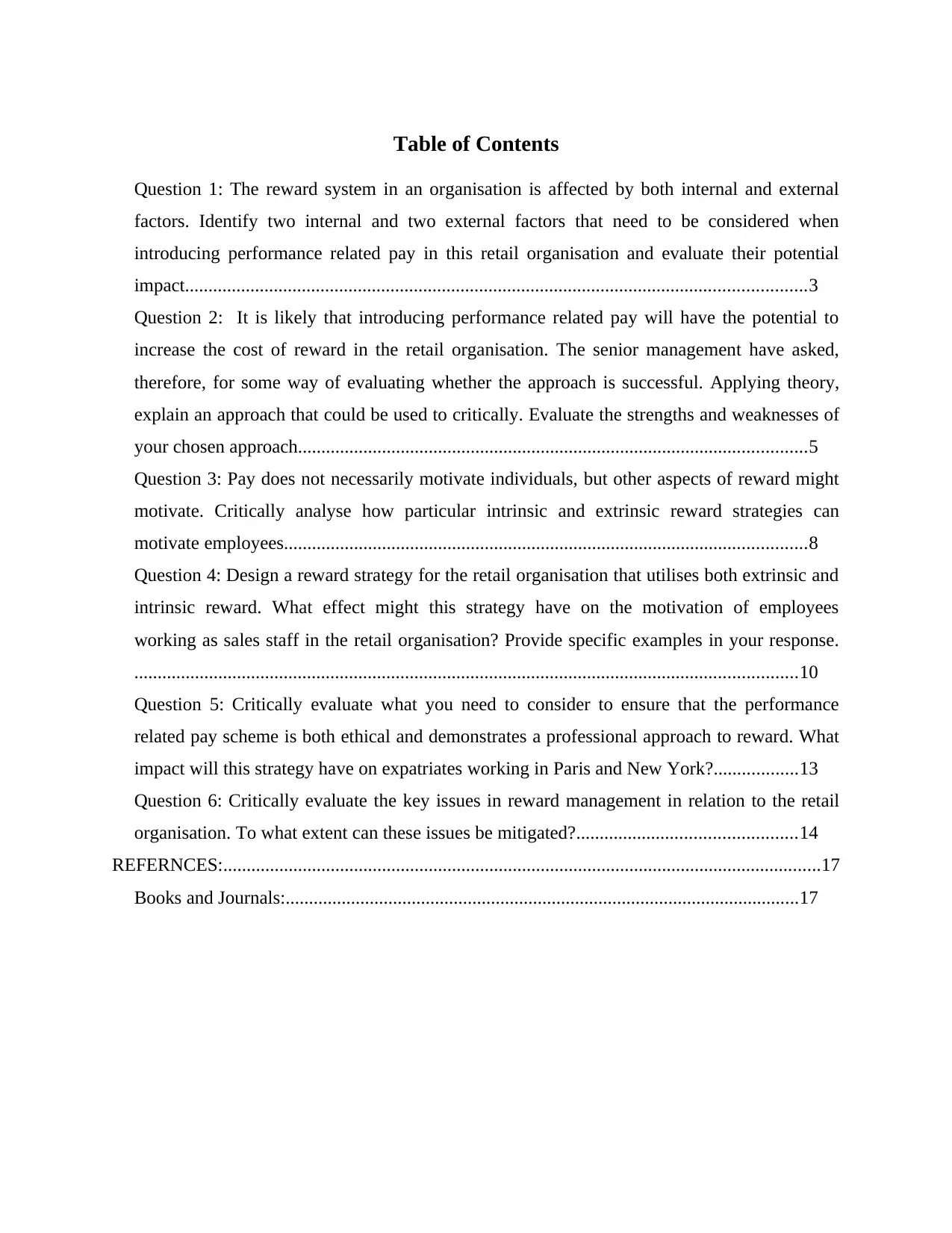
Table of Contents
Question 1: The reward system in an organisation is affected by both internal and external
factors. Identify two internal and two external factors that need to be considered when
introducing performance related pay in this retail organisation and evaluate their potential
impact.....................................................................................................................................3
Question 2: It is likely that introducing performance related pay will have the potential to
increase the cost of reward in the retail organisation. The senior management have asked,
therefore, for some way of evaluating whether the approach is successful. Applying theory,
explain an approach that could be used to critically. Evaluate the strengths and weaknesses of
your chosen approach.............................................................................................................5
Question 3: Pay does not necessarily motivate individuals, but other aspects of reward might
motivate. Critically analyse how particular intrinsic and extrinsic reward strategies can
motivate employees................................................................................................................8
Question 4: Design a reward strategy for the retail organisation that utilises both extrinsic and
intrinsic reward. What effect might this strategy have on the motivation of employees
working as sales staff in the retail organisation? Provide specific examples in your response.
..............................................................................................................................................10
Question 5: Critically evaluate what you need to consider to ensure that the performance
related pay scheme is both ethical and demonstrates a professional approach to reward. What
impact will this strategy have on expatriates working in Paris and New York?..................13
Question 6: Critically evaluate the key issues in reward management in relation to the retail
organisation. To what extent can these issues be mitigated?...............................................14
REFERNCES:................................................................................................................................17
Books and Journals:..............................................................................................................17
Question 1: The reward system in an organisation is affected by both internal and external
factors. Identify two internal and two external factors that need to be considered when
introducing performance related pay in this retail organisation and evaluate their potential
impact.....................................................................................................................................3
Question 2: It is likely that introducing performance related pay will have the potential to
increase the cost of reward in the retail organisation. The senior management have asked,
therefore, for some way of evaluating whether the approach is successful. Applying theory,
explain an approach that could be used to critically. Evaluate the strengths and weaknesses of
your chosen approach.............................................................................................................5
Question 3: Pay does not necessarily motivate individuals, but other aspects of reward might
motivate. Critically analyse how particular intrinsic and extrinsic reward strategies can
motivate employees................................................................................................................8
Question 4: Design a reward strategy for the retail organisation that utilises both extrinsic and
intrinsic reward. What effect might this strategy have on the motivation of employees
working as sales staff in the retail organisation? Provide specific examples in your response.
..............................................................................................................................................10
Question 5: Critically evaluate what you need to consider to ensure that the performance
related pay scheme is both ethical and demonstrates a professional approach to reward. What
impact will this strategy have on expatriates working in Paris and New York?..................13
Question 6: Critically evaluate the key issues in reward management in relation to the retail
organisation. To what extent can these issues be mitigated?...............................................14
REFERNCES:................................................................................................................................17
Books and Journals:..............................................................................................................17
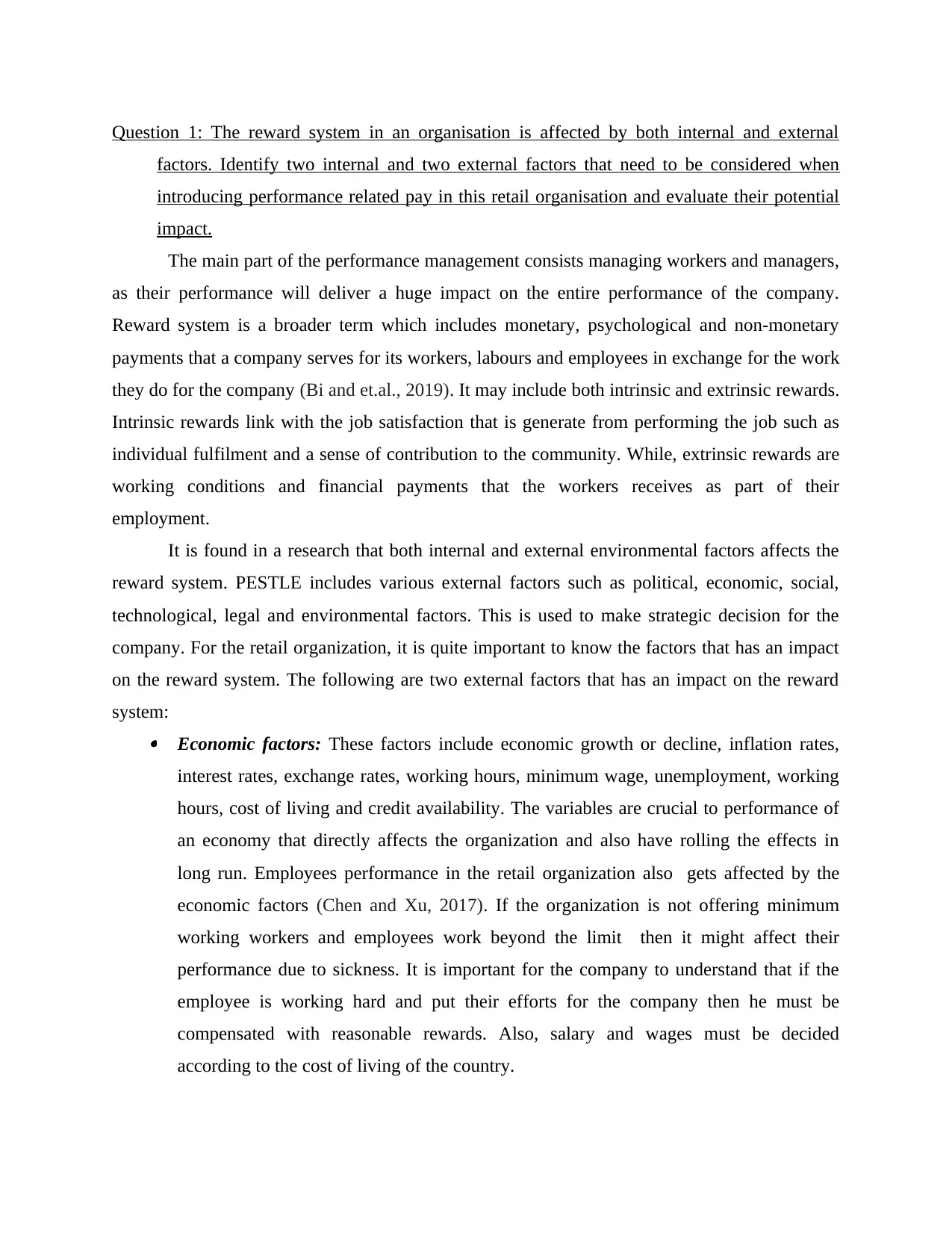
Question 1: The reward system in an organisation is affected by both internal and external
factors. Identify two internal and two external factors that need to be considered when
introducing performance related pay in this retail organisation and evaluate their potential
impact.
The main part of the performance management consists managing workers and managers,
as their performance will deliver a huge impact on the entire performance of the company.
Reward system is a broader term which includes monetary, psychological and non-monetary
payments that a company serves for its workers, labours and employees in exchange for the work
they do for the company (Bi and et.al., 2019). It may include both intrinsic and extrinsic rewards.
Intrinsic rewards link with the job satisfaction that is generate from performing the job such as
individual fulfilment and a sense of contribution to the community. While, extrinsic rewards are
working conditions and financial payments that the workers receives as part of their
employment.
It is found in a research that both internal and external environmental factors affects the
reward system. PESTLE includes various external factors such as political, economic, social,
technological, legal and environmental factors. This is used to make strategic decision for the
company. For the retail organization, it is quite important to know the factors that has an impact
on the reward system. The following are two external factors that has an impact on the reward
system: Economic factors: These factors include economic growth or decline, inflation rates,
interest rates, exchange rates, working hours, minimum wage, unemployment, working
hours, cost of living and credit availability. The variables are crucial to performance of
an economy that directly affects the organization and also have rolling the effects in
long run. Employees performance in the retail organization also gets affected by the
economic factors (Chen and Xu, 2017). If the organization is not offering minimum
working workers and employees work beyond the limit then it might affect their
performance due to sickness. It is important for the company to understand that if the
employee is working hard and put their efforts for the company then he must be
compensated with reasonable rewards. Also, salary and wages must be decided
according to the cost of living of the country.
factors. Identify two internal and two external factors that need to be considered when
introducing performance related pay in this retail organisation and evaluate their potential
impact.
The main part of the performance management consists managing workers and managers,
as their performance will deliver a huge impact on the entire performance of the company.
Reward system is a broader term which includes monetary, psychological and non-monetary
payments that a company serves for its workers, labours and employees in exchange for the work
they do for the company (Bi and et.al., 2019). It may include both intrinsic and extrinsic rewards.
Intrinsic rewards link with the job satisfaction that is generate from performing the job such as
individual fulfilment and a sense of contribution to the community. While, extrinsic rewards are
working conditions and financial payments that the workers receives as part of their
employment.
It is found in a research that both internal and external environmental factors affects the
reward system. PESTLE includes various external factors such as political, economic, social,
technological, legal and environmental factors. This is used to make strategic decision for the
company. For the retail organization, it is quite important to know the factors that has an impact
on the reward system. The following are two external factors that has an impact on the reward
system: Economic factors: These factors include economic growth or decline, inflation rates,
interest rates, exchange rates, working hours, minimum wage, unemployment, working
hours, cost of living and credit availability. The variables are crucial to performance of
an economy that directly affects the organization and also have rolling the effects in
long run. Employees performance in the retail organization also gets affected by the
economic factors (Chen and Xu, 2017). If the organization is not offering minimum
working workers and employees work beyond the limit then it might affect their
performance due to sickness. It is important for the company to understand that if the
employee is working hard and put their efforts for the company then he must be
compensated with reasonable rewards. Also, salary and wages must be decided
according to the cost of living of the country.
⊘ This is a preview!⊘
Do you want full access?
Subscribe today to unlock all pages.

Trusted by 1+ million students worldwide
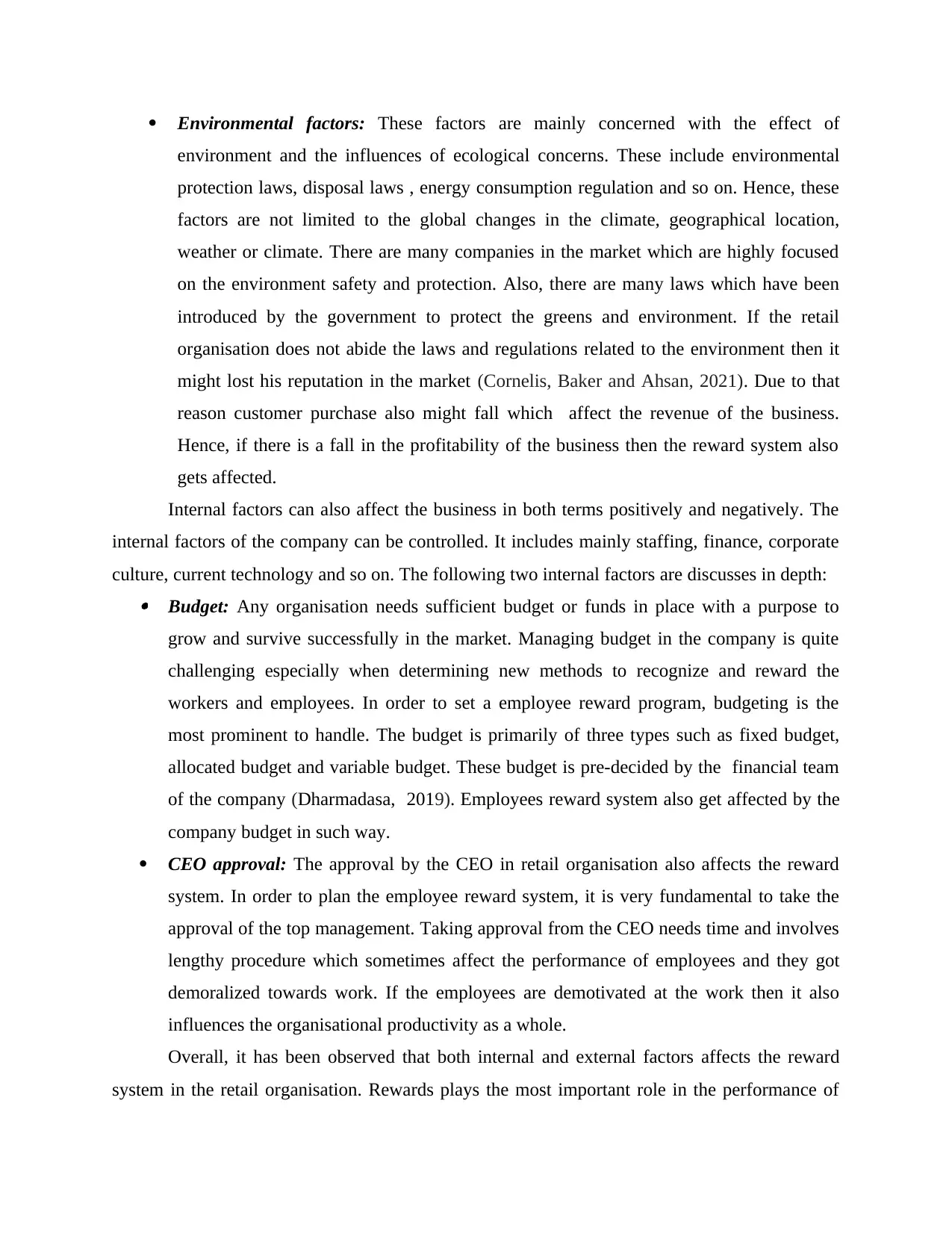
Environmental factors: These factors are mainly concerned with the effect of
environment and the influences of ecological concerns. These include environmental
protection laws, disposal laws , energy consumption regulation and so on. Hence, these
factors are not limited to the global changes in the climate, geographical location,
weather or climate. There are many companies in the market which are highly focused
on the environment safety and protection. Also, there are many laws which have been
introduced by the government to protect the greens and environment. If the retail
organisation does not abide the laws and regulations related to the environment then it
might lost his reputation in the market (Cornelis, Baker and Ahsan, 2021). Due to that
reason customer purchase also might fall which affect the revenue of the business.
Hence, if there is a fall in the profitability of the business then the reward system also
gets affected.
Internal factors can also affect the business in both terms positively and negatively. The
internal factors of the company can be controlled. It includes mainly staffing, finance, corporate
culture, current technology and so on. The following two internal factors are discusses in depth: Budget: Any organisation needs sufficient budget or funds in place with a purpose to
grow and survive successfully in the market. Managing budget in the company is quite
challenging especially when determining new methods to recognize and reward the
workers and employees. In order to set a employee reward program, budgeting is the
most prominent to handle. The budget is primarily of three types such as fixed budget,
allocated budget and variable budget. These budget is pre-decided by the financial team
of the company (Dharmadasa, 2019). Employees reward system also get affected by the
company budget in such way.
CEO approval: The approval by the CEO in retail organisation also affects the reward
system. In order to plan the employee reward system, it is very fundamental to take the
approval of the top management. Taking approval from the CEO needs time and involves
lengthy procedure which sometimes affect the performance of employees and they got
demoralized towards work. If the employees are demotivated at the work then it also
influences the organisational productivity as a whole.
Overall, it has been observed that both internal and external factors affects the reward
system in the retail organisation. Rewards plays the most important role in the performance of
environment and the influences of ecological concerns. These include environmental
protection laws, disposal laws , energy consumption regulation and so on. Hence, these
factors are not limited to the global changes in the climate, geographical location,
weather or climate. There are many companies in the market which are highly focused
on the environment safety and protection. Also, there are many laws which have been
introduced by the government to protect the greens and environment. If the retail
organisation does not abide the laws and regulations related to the environment then it
might lost his reputation in the market (Cornelis, Baker and Ahsan, 2021). Due to that
reason customer purchase also might fall which affect the revenue of the business.
Hence, if there is a fall in the profitability of the business then the reward system also
gets affected.
Internal factors can also affect the business in both terms positively and negatively. The
internal factors of the company can be controlled. It includes mainly staffing, finance, corporate
culture, current technology and so on. The following two internal factors are discusses in depth: Budget: Any organisation needs sufficient budget or funds in place with a purpose to
grow and survive successfully in the market. Managing budget in the company is quite
challenging especially when determining new methods to recognize and reward the
workers and employees. In order to set a employee reward program, budgeting is the
most prominent to handle. The budget is primarily of three types such as fixed budget,
allocated budget and variable budget. These budget is pre-decided by the financial team
of the company (Dharmadasa, 2019). Employees reward system also get affected by the
company budget in such way.
CEO approval: The approval by the CEO in retail organisation also affects the reward
system. In order to plan the employee reward system, it is very fundamental to take the
approval of the top management. Taking approval from the CEO needs time and involves
lengthy procedure which sometimes affect the performance of employees and they got
demoralized towards work. If the employees are demotivated at the work then it also
influences the organisational productivity as a whole.
Overall, it has been observed that both internal and external factors affects the reward
system in the retail organisation. Rewards plays the most important role in the performance of
Paraphrase This Document
Need a fresh take? Get an instant paraphrase of this document with our AI Paraphraser
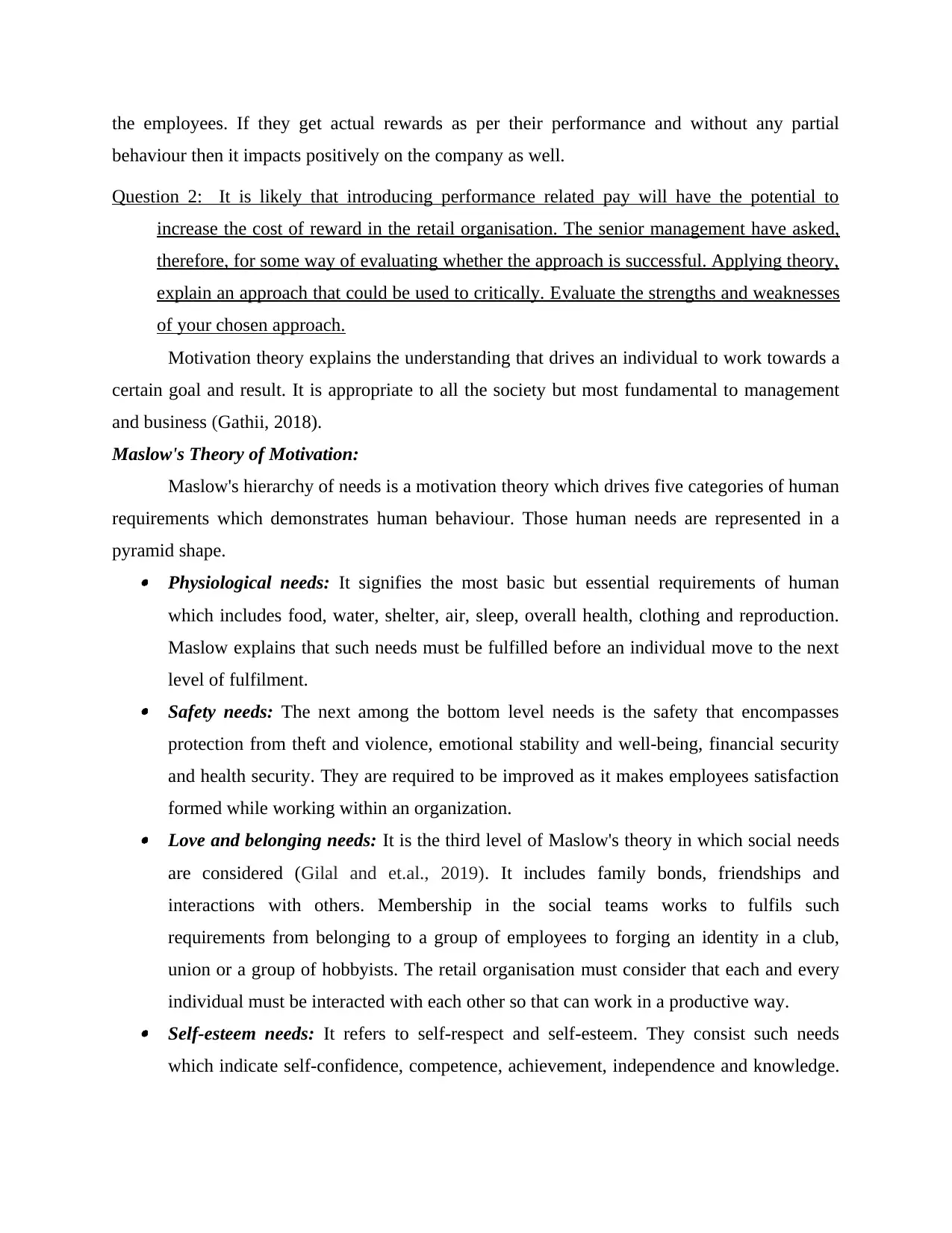
the employees. If they get actual rewards as per their performance and without any partial
behaviour then it impacts positively on the company as well.
Question 2: It is likely that introducing performance related pay will have the potential to
increase the cost of reward in the retail organisation. The senior management have asked,
therefore, for some way of evaluating whether the approach is successful. Applying theory,
explain an approach that could be used to critically. Evaluate the strengths and weaknesses
of your chosen approach.
Motivation theory explains the understanding that drives an individual to work towards a
certain goal and result. It is appropriate to all the society but most fundamental to management
and business (Gathii, 2018).
Maslow's Theory of Motivation:
Maslow's hierarchy of needs is a motivation theory which drives five categories of human
requirements which demonstrates human behaviour. Those human needs are represented in a
pyramid shape. Physiological needs: It signifies the most basic but essential requirements of human
which includes food, water, shelter, air, sleep, overall health, clothing and reproduction.
Maslow explains that such needs must be fulfilled before an individual move to the next
level of fulfilment. Safety needs: The next among the bottom level needs is the safety that encompasses
protection from theft and violence, emotional stability and well-being, financial security
and health security. They are required to be improved as it makes employees satisfaction
formed while working within an organization. Love and belonging needs: It is the third level of Maslow's theory in which social needs
are considered (Gilal and et.al., 2019). It includes family bonds, friendships and
interactions with others. Membership in the social teams works to fulfils such
requirements from belonging to a group of employees to forging an identity in a club,
union or a group of hobbyists. The retail organisation must consider that each and every
individual must be interacted with each other so that can work in a productive way. Self-esteem needs: It refers to self-respect and self-esteem. They consist such needs
which indicate self-confidence, competence, achievement, independence and knowledge.
behaviour then it impacts positively on the company as well.
Question 2: It is likely that introducing performance related pay will have the potential to
increase the cost of reward in the retail organisation. The senior management have asked,
therefore, for some way of evaluating whether the approach is successful. Applying theory,
explain an approach that could be used to critically. Evaluate the strengths and weaknesses
of your chosen approach.
Motivation theory explains the understanding that drives an individual to work towards a
certain goal and result. It is appropriate to all the society but most fundamental to management
and business (Gathii, 2018).
Maslow's Theory of Motivation:
Maslow's hierarchy of needs is a motivation theory which drives five categories of human
requirements which demonstrates human behaviour. Those human needs are represented in a
pyramid shape. Physiological needs: It signifies the most basic but essential requirements of human
which includes food, water, shelter, air, sleep, overall health, clothing and reproduction.
Maslow explains that such needs must be fulfilled before an individual move to the next
level of fulfilment. Safety needs: The next among the bottom level needs is the safety that encompasses
protection from theft and violence, emotional stability and well-being, financial security
and health security. They are required to be improved as it makes employees satisfaction
formed while working within an organization. Love and belonging needs: It is the third level of Maslow's theory in which social needs
are considered (Gilal and et.al., 2019). It includes family bonds, friendships and
interactions with others. Membership in the social teams works to fulfils such
requirements from belonging to a group of employees to forging an identity in a club,
union or a group of hobbyists. The retail organisation must consider that each and every
individual must be interacted with each other so that can work in a productive way. Self-esteem needs: It refers to self-respect and self-esteem. They consist such needs
which indicate self-confidence, competence, achievement, independence and knowledge.
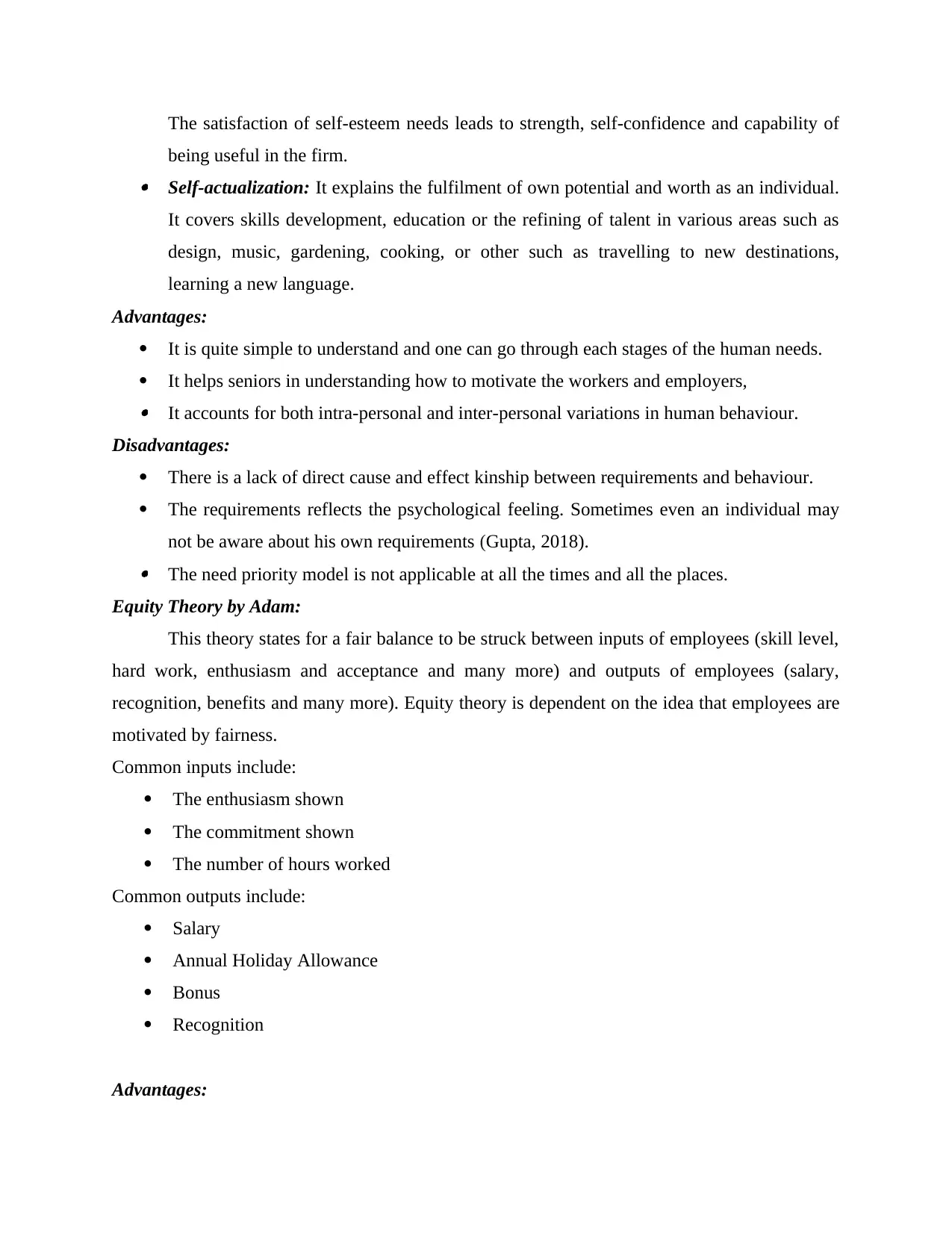
The satisfaction of self-esteem needs leads to strength, self-confidence and capability of
being useful in the firm. Self-actualization: It explains the fulfilment of own potential and worth as an individual.
It covers skills development, education or the refining of talent in various areas such as
design, music, gardening, cooking, or other such as travelling to new destinations,
learning a new language.
Advantages:
It is quite simple to understand and one can go through each stages of the human needs.
It helps seniors in understanding how to motivate the workers and employers, It accounts for both intra-personal and inter-personal variations in human behaviour.
Disadvantages:
There is a lack of direct cause and effect kinship between requirements and behaviour.
The requirements reflects the psychological feeling. Sometimes even an individual may
not be aware about his own requirements (Gupta, 2018). The need priority model is not applicable at all the times and all the places.
Equity Theory by Adam:
This theory states for a fair balance to be struck between inputs of employees (skill level,
hard work, enthusiasm and acceptance and many more) and outputs of employees (salary,
recognition, benefits and many more). Equity theory is dependent on the idea that employees are
motivated by fairness.
Common inputs include:
The enthusiasm shown
The commitment shown
The number of hours worked
Common outputs include:
Salary
Annual Holiday Allowance
Bonus
Recognition
Advantages:
being useful in the firm. Self-actualization: It explains the fulfilment of own potential and worth as an individual.
It covers skills development, education or the refining of talent in various areas such as
design, music, gardening, cooking, or other such as travelling to new destinations,
learning a new language.
Advantages:
It is quite simple to understand and one can go through each stages of the human needs.
It helps seniors in understanding how to motivate the workers and employers, It accounts for both intra-personal and inter-personal variations in human behaviour.
Disadvantages:
There is a lack of direct cause and effect kinship between requirements and behaviour.
The requirements reflects the psychological feeling. Sometimes even an individual may
not be aware about his own requirements (Gupta, 2018). The need priority model is not applicable at all the times and all the places.
Equity Theory by Adam:
This theory states for a fair balance to be struck between inputs of employees (skill level,
hard work, enthusiasm and acceptance and many more) and outputs of employees (salary,
recognition, benefits and many more). Equity theory is dependent on the idea that employees are
motivated by fairness.
Common inputs include:
The enthusiasm shown
The commitment shown
The number of hours worked
Common outputs include:
Salary
Annual Holiday Allowance
Bonus
Recognition
Advantages:
⊘ This is a preview!⊘
Do you want full access?
Subscribe today to unlock all pages.

Trusted by 1+ million students worldwide
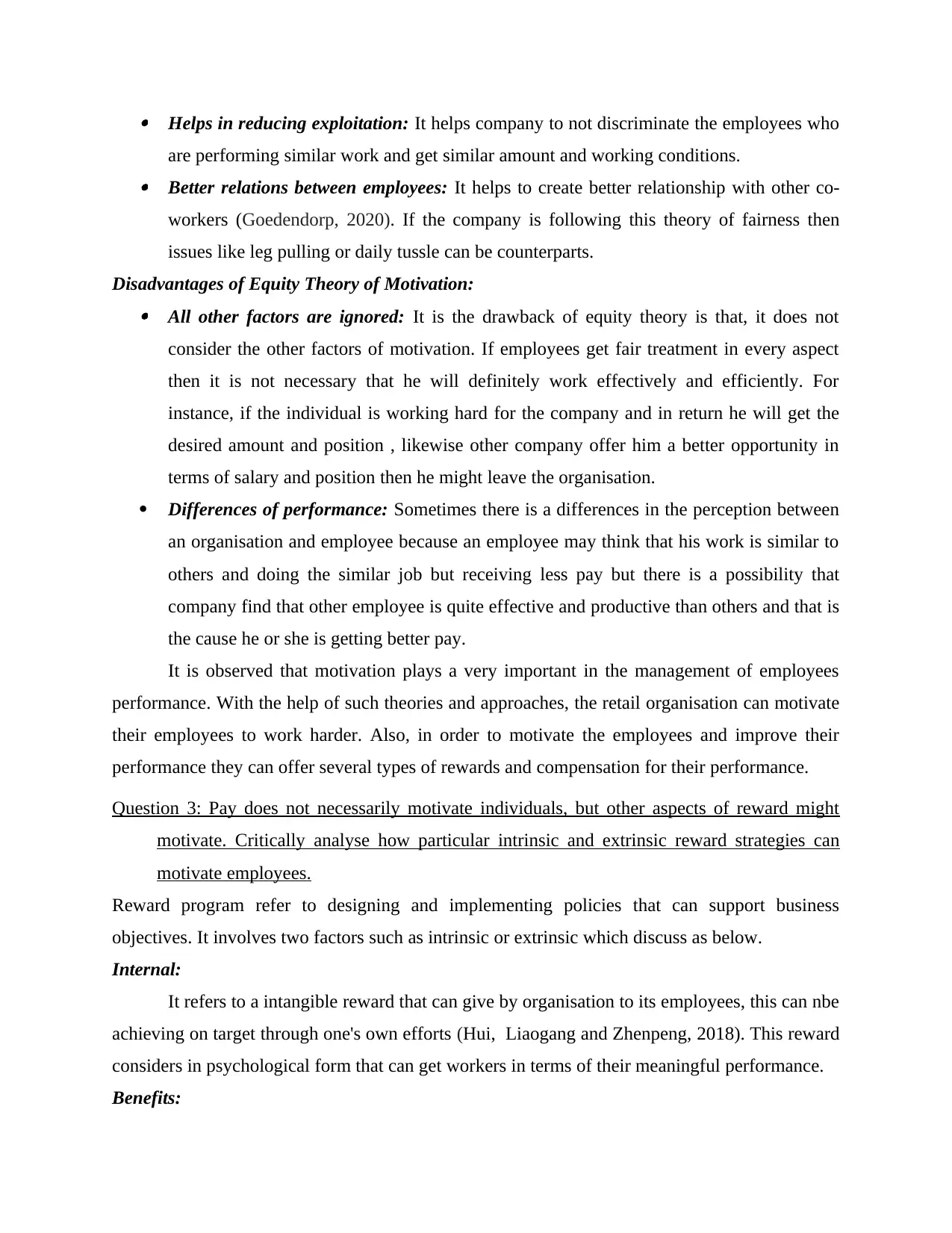
Helps in reducing exploitation: It helps company to not discriminate the employees who
are performing similar work and get similar amount and working conditions. Better relations between employees: It helps to create better relationship with other co-
workers (Goedendorp, 2020). If the company is following this theory of fairness then
issues like leg pulling or daily tussle can be counterparts.
Disadvantages of Equity Theory of Motivation: All other factors are ignored: It is the drawback of equity theory is that, it does not
consider the other factors of motivation. If employees get fair treatment in every aspect
then it is not necessary that he will definitely work effectively and efficiently. For
instance, if the individual is working hard for the company and in return he will get the
desired amount and position , likewise other company offer him a better opportunity in
terms of salary and position then he might leave the organisation.
Differences of performance: Sometimes there is a differences in the perception between
an organisation and employee because an employee may think that his work is similar to
others and doing the similar job but receiving less pay but there is a possibility that
company find that other employee is quite effective and productive than others and that is
the cause he or she is getting better pay.
It is observed that motivation plays a very important in the management of employees
performance. With the help of such theories and approaches, the retail organisation can motivate
their employees to work harder. Also, in order to motivate the employees and improve their
performance they can offer several types of rewards and compensation for their performance.
Question 3: Pay does not necessarily motivate individuals, but other aspects of reward might
motivate. Critically analyse how particular intrinsic and extrinsic reward strategies can
motivate employees.
Reward program refer to designing and implementing policies that can support business
objectives. It involves two factors such as intrinsic or extrinsic which discuss as below.
Internal:
It refers to a intangible reward that can give by organisation to its employees, this can nbe
achieving on target through one's own efforts (Hui, Liaogang and Zhenpeng, 2018). This reward
considers in psychological form that can get workers in terms of their meaningful performance.
Benefits:
are performing similar work and get similar amount and working conditions. Better relations between employees: It helps to create better relationship with other co-
workers (Goedendorp, 2020). If the company is following this theory of fairness then
issues like leg pulling or daily tussle can be counterparts.
Disadvantages of Equity Theory of Motivation: All other factors are ignored: It is the drawback of equity theory is that, it does not
consider the other factors of motivation. If employees get fair treatment in every aspect
then it is not necessary that he will definitely work effectively and efficiently. For
instance, if the individual is working hard for the company and in return he will get the
desired amount and position , likewise other company offer him a better opportunity in
terms of salary and position then he might leave the organisation.
Differences of performance: Sometimes there is a differences in the perception between
an organisation and employee because an employee may think that his work is similar to
others and doing the similar job but receiving less pay but there is a possibility that
company find that other employee is quite effective and productive than others and that is
the cause he or she is getting better pay.
It is observed that motivation plays a very important in the management of employees
performance. With the help of such theories and approaches, the retail organisation can motivate
their employees to work harder. Also, in order to motivate the employees and improve their
performance they can offer several types of rewards and compensation for their performance.
Question 3: Pay does not necessarily motivate individuals, but other aspects of reward might
motivate. Critically analyse how particular intrinsic and extrinsic reward strategies can
motivate employees.
Reward program refer to designing and implementing policies that can support business
objectives. It involves two factors such as intrinsic or extrinsic which discuss as below.
Internal:
It refers to a intangible reward that can give by organisation to its employees, this can nbe
achieving on target through one's own efforts (Hui, Liaogang and Zhenpeng, 2018). This reward
considers in psychological form that can get workers in terms of their meaningful performance.
Benefits:
Paraphrase This Document
Need a fresh take? Get an instant paraphrase of this document with our AI Paraphraser
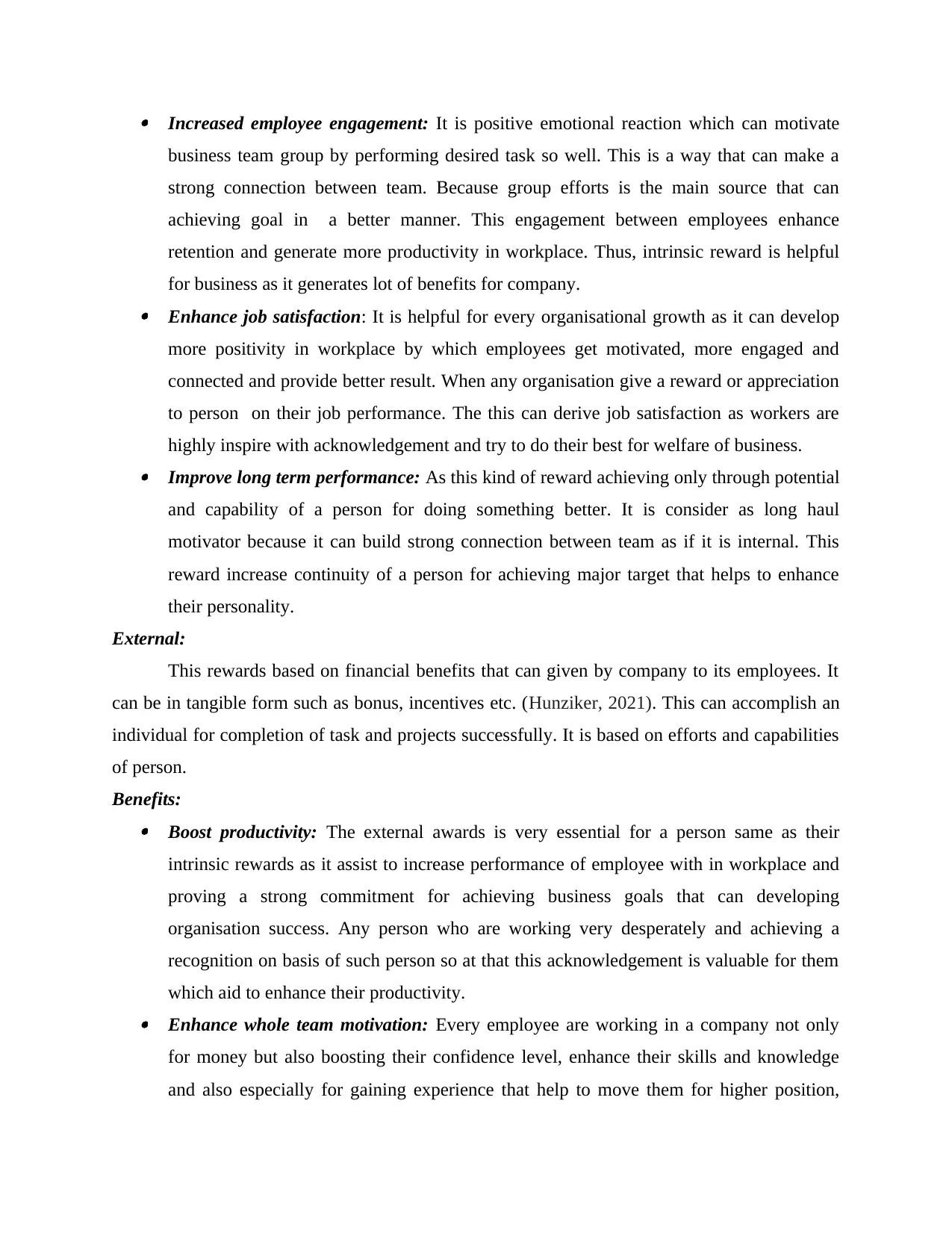
Increased employee engagement: It is positive emotional reaction which can motivate
business team group by performing desired task so well. This is a way that can make a
strong connection between team. Because group efforts is the main source that can
achieving goal in a better manner. This engagement between employees enhance
retention and generate more productivity in workplace. Thus, intrinsic reward is helpful
for business as it generates lot of benefits for company. Enhance job satisfaction: It is helpful for every organisational growth as it can develop
more positivity in workplace by which employees get motivated, more engaged and
connected and provide better result. When any organisation give a reward or appreciation
to person on their job performance. The this can derive job satisfaction as workers are
highly inspire with acknowledgement and try to do their best for welfare of business. Improve long term performance: As this kind of reward achieving only through potential
and capability of a person for doing something better. It is consider as long haul
motivator because it can build strong connection between team as if it is internal. This
reward increase continuity of a person for achieving major target that helps to enhance
their personality.
External:
This rewards based on financial benefits that can given by company to its employees. It
can be in tangible form such as bonus, incentives etc. (Hunziker, 2021). This can accomplish an
individual for completion of task and projects successfully. It is based on efforts and capabilities
of person.
Benefits: Boost productivity: The external awards is very essential for a person same as their
intrinsic rewards as it assist to increase performance of employee with in workplace and
proving a strong commitment for achieving business goals that can developing
organisation success. Any person who are working very desperately and achieving a
recognition on basis of such person so at that this acknowledgement is valuable for them
which aid to enhance their productivity. Enhance whole team motivation: Every employee are working in a company not only
for money but also boosting their confidence level, enhance their skills and knowledge
and also especially for gaining experience that help to move them for higher position,
business team group by performing desired task so well. This is a way that can make a
strong connection between team. Because group efforts is the main source that can
achieving goal in a better manner. This engagement between employees enhance
retention and generate more productivity in workplace. Thus, intrinsic reward is helpful
for business as it generates lot of benefits for company. Enhance job satisfaction: It is helpful for every organisational growth as it can develop
more positivity in workplace by which employees get motivated, more engaged and
connected and provide better result. When any organisation give a reward or appreciation
to person on their job performance. The this can derive job satisfaction as workers are
highly inspire with acknowledgement and try to do their best for welfare of business. Improve long term performance: As this kind of reward achieving only through potential
and capability of a person for doing something better. It is consider as long haul
motivator because it can build strong connection between team as if it is internal. This
reward increase continuity of a person for achieving major target that helps to enhance
their personality.
External:
This rewards based on financial benefits that can given by company to its employees. It
can be in tangible form such as bonus, incentives etc. (Hunziker, 2021). This can accomplish an
individual for completion of task and projects successfully. It is based on efforts and capabilities
of person.
Benefits: Boost productivity: The external awards is very essential for a person same as their
intrinsic rewards as it assist to increase performance of employee with in workplace and
proving a strong commitment for achieving business goals that can developing
organisation success. Any person who are working very desperately and achieving a
recognition on basis of such person so at that this acknowledgement is valuable for them
which aid to enhance their productivity. Enhance whole team motivation: Every employee are working in a company not only
for money but also boosting their confidence level, enhance their skills and knowledge
and also especially for gaining experience that help to move them for higher position,
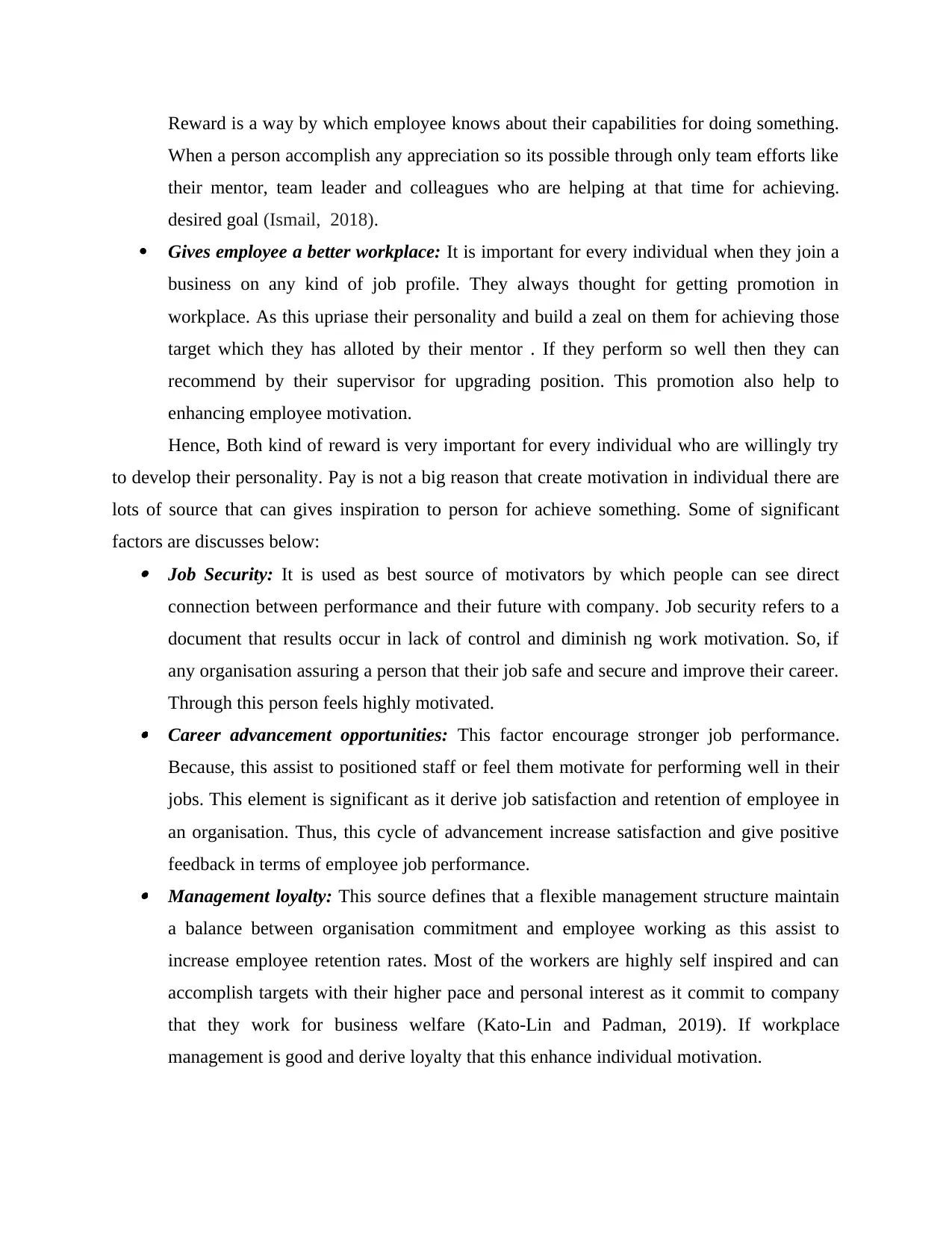
Reward is a way by which employee knows about their capabilities for doing something.
When a person accomplish any appreciation so its possible through only team efforts like
their mentor, team leader and colleagues who are helping at that time for achieving.
desired goal (Ismail, 2018).
Gives employee a better workplace: It is important for every individual when they join a
business on any kind of job profile. They always thought for getting promotion in
workplace. As this upriase their personality and build a zeal on them for achieving those
target which they has alloted by their mentor . If they perform so well then they can
recommend by their supervisor for upgrading position. This promotion also help to
enhancing employee motivation.
Hence, Both kind of reward is very important for every individual who are willingly try
to develop their personality. Pay is not a big reason that create motivation in individual there are
lots of source that can gives inspiration to person for achieve something. Some of significant
factors are discusses below: Job Security: It is used as best source of motivators by which people can see direct
connection between performance and their future with company. Job security refers to a
document that results occur in lack of control and diminish ng work motivation. So, if
any organisation assuring a person that their job safe and secure and improve their career.
Through this person feels highly motivated. Career advancement opportunities: This factor encourage stronger job performance.
Because, this assist to positioned staff or feel them motivate for performing well in their
jobs. This element is significant as it derive job satisfaction and retention of employee in
an organisation. Thus, this cycle of advancement increase satisfaction and give positive
feedback in terms of employee job performance. Management loyalty: This source defines that a flexible management structure maintain
a balance between organisation commitment and employee working as this assist to
increase employee retention rates. Most of the workers are highly self inspired and can
accomplish targets with their higher pace and personal interest as it commit to company
that they work for business welfare (Kato-Lin and Padman, 2019). If workplace
management is good and derive loyalty that this enhance individual motivation.
When a person accomplish any appreciation so its possible through only team efforts like
their mentor, team leader and colleagues who are helping at that time for achieving.
desired goal (Ismail, 2018).
Gives employee a better workplace: It is important for every individual when they join a
business on any kind of job profile. They always thought for getting promotion in
workplace. As this upriase their personality and build a zeal on them for achieving those
target which they has alloted by their mentor . If they perform so well then they can
recommend by their supervisor for upgrading position. This promotion also help to
enhancing employee motivation.
Hence, Both kind of reward is very important for every individual who are willingly try
to develop their personality. Pay is not a big reason that create motivation in individual there are
lots of source that can gives inspiration to person for achieve something. Some of significant
factors are discusses below: Job Security: It is used as best source of motivators by which people can see direct
connection between performance and their future with company. Job security refers to a
document that results occur in lack of control and diminish ng work motivation. So, if
any organisation assuring a person that their job safe and secure and improve their career.
Through this person feels highly motivated. Career advancement opportunities: This factor encourage stronger job performance.
Because, this assist to positioned staff or feel them motivate for performing well in their
jobs. This element is significant as it derive job satisfaction and retention of employee in
an organisation. Thus, this cycle of advancement increase satisfaction and give positive
feedback in terms of employee job performance. Management loyalty: This source defines that a flexible management structure maintain
a balance between organisation commitment and employee working as this assist to
increase employee retention rates. Most of the workers are highly self inspired and can
accomplish targets with their higher pace and personal interest as it commit to company
that they work for business welfare (Kato-Lin and Padman, 2019). If workplace
management is good and derive loyalty that this enhance individual motivation.
⊘ This is a preview!⊘
Do you want full access?
Subscribe today to unlock all pages.

Trusted by 1+ million students worldwide
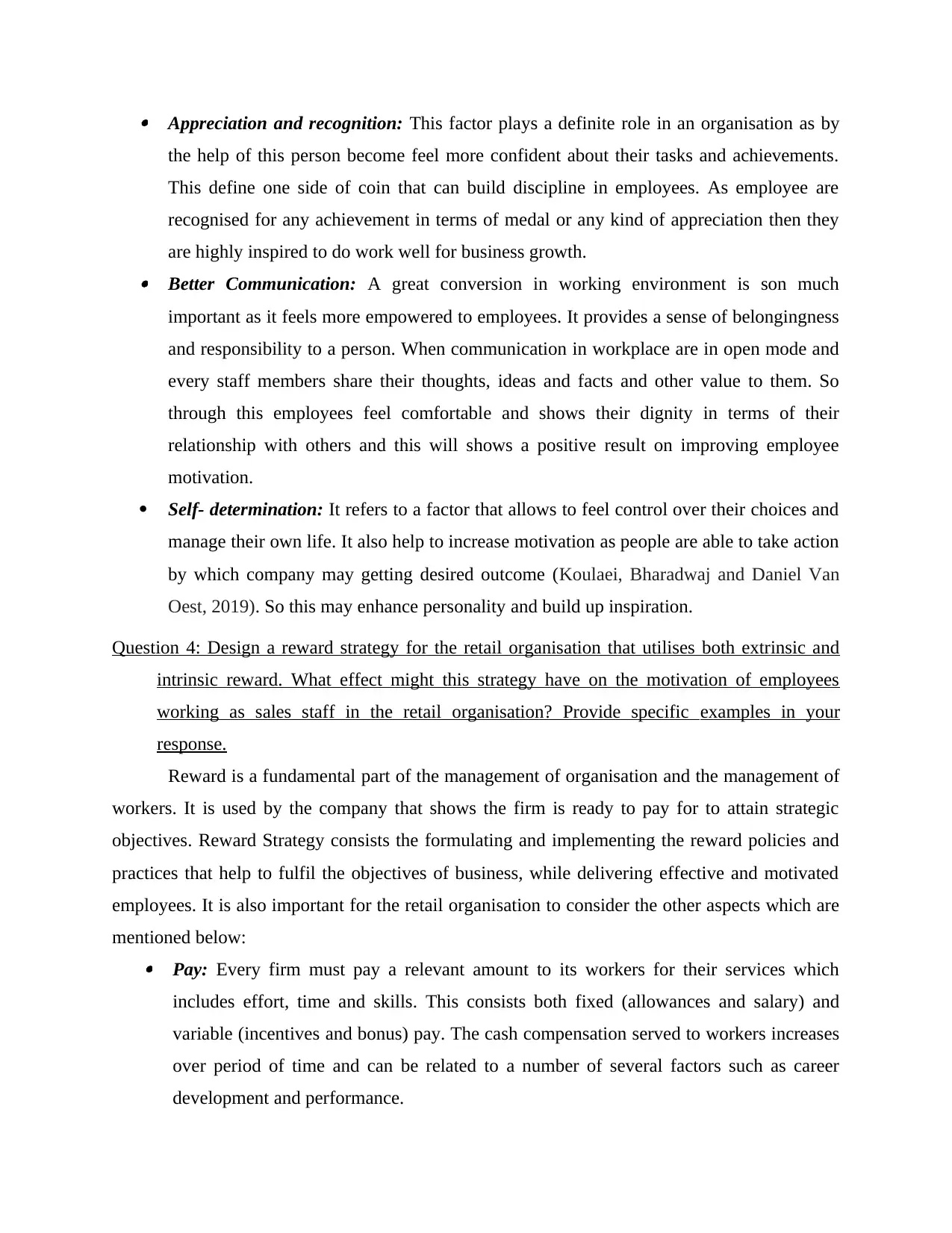
Appreciation and recognition: This factor plays a definite role in an organisation as by
the help of this person become feel more confident about their tasks and achievements.
This define one side of coin that can build discipline in employees. As employee are
recognised for any achievement in terms of medal or any kind of appreciation then they
are highly inspired to do work well for business growth. Better Communication: A great conversion in working environment is son much
important as it feels more empowered to employees. It provides a sense of belongingness
and responsibility to a person. When communication in workplace are in open mode and
every staff members share their thoughts, ideas and facts and other value to them. So
through this employees feel comfortable and shows their dignity in terms of their
relationship with others and this will shows a positive result on improving employee
motivation.
Self- determination: It refers to a factor that allows to feel control over their choices and
manage their own life. It also help to increase motivation as people are able to take action
by which company may getting desired outcome (Koulaei, Bharadwaj and Daniel Van
Oest, 2019). So this may enhance personality and build up inspiration.
Question 4: Design a reward strategy for the retail organisation that utilises both extrinsic and
intrinsic reward. What effect might this strategy have on the motivation of employees
working as sales staff in the retail organisation? Provide specific examples in your
response.
Reward is a fundamental part of the management of organisation and the management of
workers. It is used by the company that shows the firm is ready to pay for to attain strategic
objectives. Reward Strategy consists the formulating and implementing the reward policies and
practices that help to fulfil the objectives of business, while delivering effective and motivated
employees. It is also important for the retail organisation to consider the other aspects which are
mentioned below: Pay: Every firm must pay a relevant amount to its workers for their services which
includes effort, time and skills. This consists both fixed (allowances and salary) and
variable (incentives and bonus) pay. The cash compensation served to workers increases
over period of time and can be related to a number of several factors such as career
development and performance.
the help of this person become feel more confident about their tasks and achievements.
This define one side of coin that can build discipline in employees. As employee are
recognised for any achievement in terms of medal or any kind of appreciation then they
are highly inspired to do work well for business growth. Better Communication: A great conversion in working environment is son much
important as it feels more empowered to employees. It provides a sense of belongingness
and responsibility to a person. When communication in workplace are in open mode and
every staff members share their thoughts, ideas and facts and other value to them. So
through this employees feel comfortable and shows their dignity in terms of their
relationship with others and this will shows a positive result on improving employee
motivation.
Self- determination: It refers to a factor that allows to feel control over their choices and
manage their own life. It also help to increase motivation as people are able to take action
by which company may getting desired outcome (Koulaei, Bharadwaj and Daniel Van
Oest, 2019). So this may enhance personality and build up inspiration.
Question 4: Design a reward strategy for the retail organisation that utilises both extrinsic and
intrinsic reward. What effect might this strategy have on the motivation of employees
working as sales staff in the retail organisation? Provide specific examples in your
response.
Reward is a fundamental part of the management of organisation and the management of
workers. It is used by the company that shows the firm is ready to pay for to attain strategic
objectives. Reward Strategy consists the formulating and implementing the reward policies and
practices that help to fulfil the objectives of business, while delivering effective and motivated
employees. It is also important for the retail organisation to consider the other aspects which are
mentioned below: Pay: Every firm must pay a relevant amount to its workers for their services which
includes effort, time and skills. This consists both fixed (allowances and salary) and
variable (incentives and bonus) pay. The cash compensation served to workers increases
over period of time and can be related to a number of several factors such as career
development and performance.
Paraphrase This Document
Need a fresh take? Get an instant paraphrase of this document with our AI Paraphraser
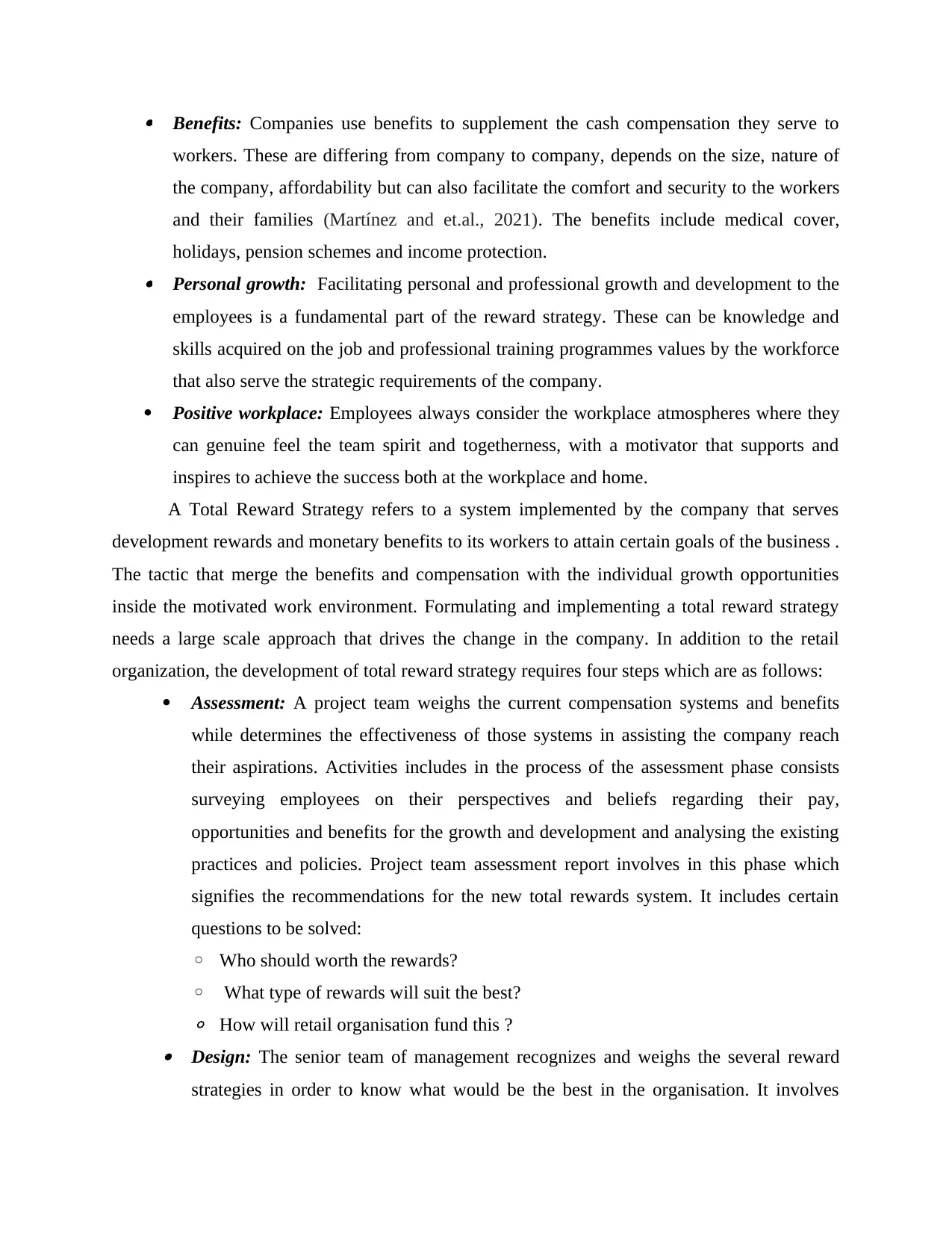
Benefits: Companies use benefits to supplement the cash compensation they serve to
workers. These are differing from company to company, depends on the size, nature of
the company, affordability but can also facilitate the comfort and security to the workers
and their families (Martínez and et.al., 2021). The benefits include medical cover,
holidays, pension schemes and income protection. Personal growth: Facilitating personal and professional growth and development to the
employees is a fundamental part of the reward strategy. These can be knowledge and
skills acquired on the job and professional training programmes values by the workforce
that also serve the strategic requirements of the company.
Positive workplace: Employees always consider the workplace atmospheres where they
can genuine feel the team spirit and togetherness, with a motivator that supports and
inspires to achieve the success both at the workplace and home.
A Total Reward Strategy refers to a system implemented by the company that serves
development rewards and monetary benefits to its workers to attain certain goals of the business .
The tactic that merge the benefits and compensation with the individual growth opportunities
inside the motivated work environment. Formulating and implementing a total reward strategy
needs a large scale approach that drives the change in the company. In addition to the retail
organization, the development of total reward strategy requires four steps which are as follows:
Assessment: A project team weighs the current compensation systems and benefits
while determines the effectiveness of those systems in assisting the company reach
their aspirations. Activities includes in the process of the assessment phase consists
surveying employees on their perspectives and beliefs regarding their pay,
opportunities and benefits for the growth and development and analysing the existing
practices and policies. Project team assessment report involves in this phase which
signifies the recommendations for the new total rewards system. It includes certain
questions to be solved:
◦ Who should worth the rewards?
◦ What type of rewards will suit the best?
◦ How will retail organisation fund this ?
Design: The senior team of management recognizes and weighs the several reward
strategies in order to know what would be the best in the organisation. It involves
workers. These are differing from company to company, depends on the size, nature of
the company, affordability but can also facilitate the comfort and security to the workers
and their families (Martínez and et.al., 2021). The benefits include medical cover,
holidays, pension schemes and income protection. Personal growth: Facilitating personal and professional growth and development to the
employees is a fundamental part of the reward strategy. These can be knowledge and
skills acquired on the job and professional training programmes values by the workforce
that also serve the strategic requirements of the company.
Positive workplace: Employees always consider the workplace atmospheres where they
can genuine feel the team spirit and togetherness, with a motivator that supports and
inspires to achieve the success both at the workplace and home.
A Total Reward Strategy refers to a system implemented by the company that serves
development rewards and monetary benefits to its workers to attain certain goals of the business .
The tactic that merge the benefits and compensation with the individual growth opportunities
inside the motivated work environment. Formulating and implementing a total reward strategy
needs a large scale approach that drives the change in the company. In addition to the retail
organization, the development of total reward strategy requires four steps which are as follows:
Assessment: A project team weighs the current compensation systems and benefits
while determines the effectiveness of those systems in assisting the company reach
their aspirations. Activities includes in the process of the assessment phase consists
surveying employees on their perspectives and beliefs regarding their pay,
opportunities and benefits for the growth and development and analysing the existing
practices and policies. Project team assessment report involves in this phase which
signifies the recommendations for the new total rewards system. It includes certain
questions to be solved:
◦ Who should worth the rewards?
◦ What type of rewards will suit the best?
◦ How will retail organisation fund this ?
Design: The senior team of management recognizes and weighs the several reward
strategies in order to know what would be the best in the organisation. It involves
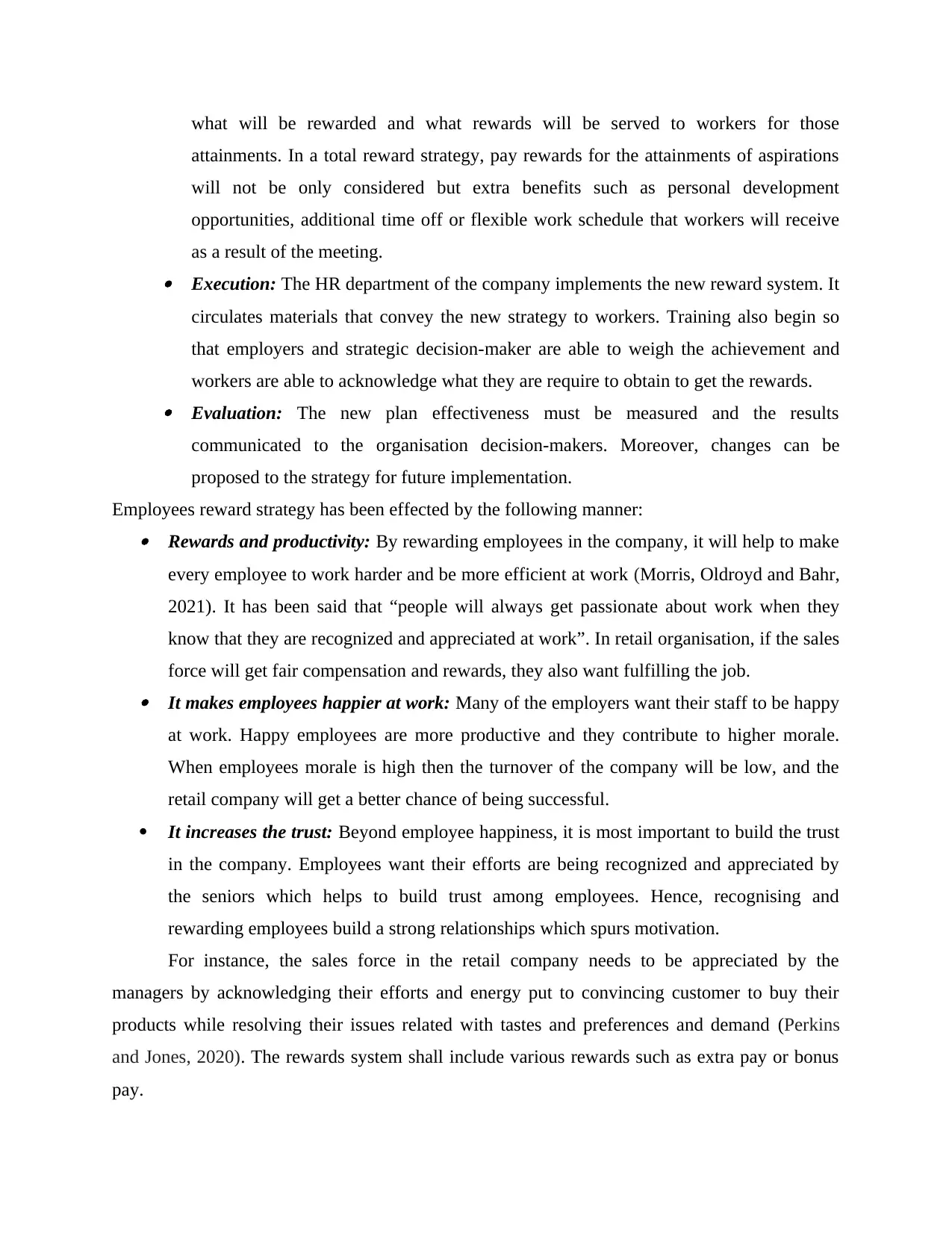
what will be rewarded and what rewards will be served to workers for those
attainments. In a total reward strategy, pay rewards for the attainments of aspirations
will not be only considered but extra benefits such as personal development
opportunities, additional time off or flexible work schedule that workers will receive
as a result of the meeting.
Execution: The HR department of the company implements the new reward system. It
circulates materials that convey the new strategy to workers. Training also begin so
that employers and strategic decision-maker are able to weigh the achievement and
workers are able to acknowledge what they are require to obtain to get the rewards.
Evaluation: The new plan effectiveness must be measured and the results
communicated to the organisation decision-makers. Moreover, changes can be
proposed to the strategy for future implementation.
Employees reward strategy has been effected by the following manner: Rewards and productivity: By rewarding employees in the company, it will help to make
every employee to work harder and be more efficient at work (Morris, Oldroyd and Bahr,
2021). It has been said that “people will always get passionate about work when they
know that they are recognized and appreciated at work”. In retail organisation, if the sales
force will get fair compensation and rewards, they also want fulfilling the job. It makes employees happier at work: Many of the employers want their staff to be happy
at work. Happy employees are more productive and they contribute to higher morale.
When employees morale is high then the turnover of the company will be low, and the
retail company will get a better chance of being successful.
It increases the trust: Beyond employee happiness, it is most important to build the trust
in the company. Employees want their efforts are being recognized and appreciated by
the seniors which helps to build trust among employees. Hence, recognising and
rewarding employees build a strong relationships which spurs motivation.
For instance, the sales force in the retail company needs to be appreciated by the
managers by acknowledging their efforts and energy put to convincing customer to buy their
products while resolving their issues related with tastes and preferences and demand (Perkins
and Jones, 2020). The rewards system shall include various rewards such as extra pay or bonus
pay.
attainments. In a total reward strategy, pay rewards for the attainments of aspirations
will not be only considered but extra benefits such as personal development
opportunities, additional time off or flexible work schedule that workers will receive
as a result of the meeting.
Execution: The HR department of the company implements the new reward system. It
circulates materials that convey the new strategy to workers. Training also begin so
that employers and strategic decision-maker are able to weigh the achievement and
workers are able to acknowledge what they are require to obtain to get the rewards.
Evaluation: The new plan effectiveness must be measured and the results
communicated to the organisation decision-makers. Moreover, changes can be
proposed to the strategy for future implementation.
Employees reward strategy has been effected by the following manner: Rewards and productivity: By rewarding employees in the company, it will help to make
every employee to work harder and be more efficient at work (Morris, Oldroyd and Bahr,
2021). It has been said that “people will always get passionate about work when they
know that they are recognized and appreciated at work”. In retail organisation, if the sales
force will get fair compensation and rewards, they also want fulfilling the job. It makes employees happier at work: Many of the employers want their staff to be happy
at work. Happy employees are more productive and they contribute to higher morale.
When employees morale is high then the turnover of the company will be low, and the
retail company will get a better chance of being successful.
It increases the trust: Beyond employee happiness, it is most important to build the trust
in the company. Employees want their efforts are being recognized and appreciated by
the seniors which helps to build trust among employees. Hence, recognising and
rewarding employees build a strong relationships which spurs motivation.
For instance, the sales force in the retail company needs to be appreciated by the
managers by acknowledging their efforts and energy put to convincing customer to buy their
products while resolving their issues related with tastes and preferences and demand (Perkins
and Jones, 2020). The rewards system shall include various rewards such as extra pay or bonus
pay.
⊘ This is a preview!⊘
Do you want full access?
Subscribe today to unlock all pages.

Trusted by 1+ million students worldwide
1 out of 19
Related Documents
Your All-in-One AI-Powered Toolkit for Academic Success.
+13062052269
info@desklib.com
Available 24*7 on WhatsApp / Email
![[object Object]](/_next/static/media/star-bottom.7253800d.svg)
Unlock your academic potential
Copyright © 2020–2025 A2Z Services. All Rights Reserved. Developed and managed by ZUCOL.





